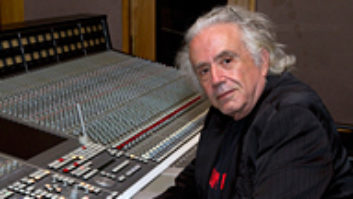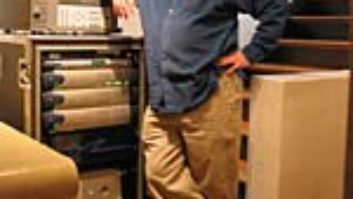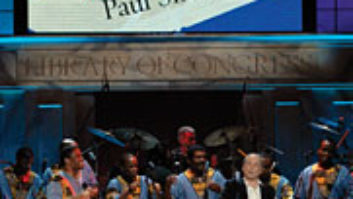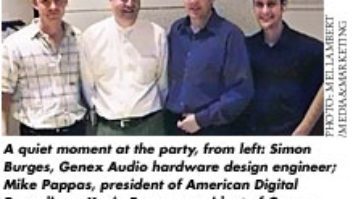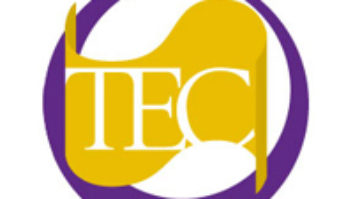The music industry has long understood that an audio project isn’t really ready to distribute until it’s been polished by expert hands in the mastering room. In recent years, a handful of top-flight mastering engineers have even achieved a sort of mythic status within the recording biz, like holy men who can turn water into wine. But in the film world, there’s generally been little attention paid to those who perform the analogous function of preparing soundtrack audio for home-video release. Transfer engineers may have done their best, but VHS afforded limited opportunities to make a big impression, and the work was largely anonymous.
With the rise of DVD-Video, the situation is changing. It’s obvious to anyone with ears that the collection of disparate materials that finds its way onto the typical disc needs some attention in order to flow together as a unified whole. Specializing in this work, Brant Biles and Robert Margouleff of Mi Casa Studios, Los Angeles, have developed a lengthy list of credits and a place on everyone’s short list of experts on audio for DVD. “We aim like a laser beam and concentrate on one thing,” Margouleff says, “which is the preparation of audio — mastering and mixing — for DVD.”
Margouleff’s DVD-Video work is a change of pace from his extensive background in music production, including the co-producing and co-engineering of the classic Stevie Wonder Grammy-winners Innervisions and Fulfillingness’ First Finale. He’s been engineering with Biles for some 15 years, during which time the pair worked closely with DTS to fill the surround music pipeline with both classical and contemporary releases. As DVD took off, they made the transition into sound-for-picture and founded Mi Casa — originally in Margouleff’s apartment. It’s now a three-room facility in a home in the Los Angeles hills.
Margouleff has now moved away from day-to-day engineering duties, concentrating more on the business side of the operation. “As chief engineer at Mi Casa,” Biles says, “I have two engineers who work with me, Holger Thiele and John Bird. Robert deals with production and operations.”
Mi Casa’s current DVD-Video credits include some of the highest-profile films of the past year, including Lord of the Rings: Fellowship of the Ring, John Q and Austin Powers in Goldmember. There are also classics such as Rio Grande and High Noon, as well as upcoming work remixing eight early James Bond films in 5.1 surround from the original 3, 8 and 16-track recordings. Given the pair’s record industry backgrounds, we began our interview by discussing how they moved from music to movies.
Your projects these days are pretty much all related to audio for feature-film DVD-Video releases. How did you wind up in what is essentially an extension of the film industry?
Margouleff: Prior to doing DVDs, we had about a two-year stint preparing surround materials for DTS. We met David DelGrosso [VP of marketing at DTS Entertainment], who said he needed to have some stuff mixed in surround, and I had some experience in quad mixing from my Stevie Wonder days. So, Brant and I started repurposing some classical music for them. And then through my Motown connection, we got a little group called Boyz II Men. And not only did we mix it in surround with Brant at the helm, but we also sort of introduced the then-new Capricorn console as a surround mixing system at the Enterprise. We came out with a very, very good product, which I still think in many ways stands up today as a good example of what surround can really be.
Biles: After the Boyz II Men project, I did some work with Ed Cherney on Bonnie Raitt. We also did an anthology of Marvin Gaye’s greatest hits for DTS. Everybody thought that the DTS surround format was going to take off like gangbusters, and everybody and their uncle were going to want to have their album mixed into 5.1. But as we know, that has not been the case. There was a time when, we were knocking at record companies doors, and they didn’t really get it, didn’t want to hear it.
So Bob and I then asked ourselves how we could apply this newfound technology, knowledge and experience to do surround music mixing on a broader scale. Who really needed our services? As it turned out, the people who really understand surround are film mixers and film composers, and translating that to DVD just seemed like a natural step for us. We found that, for the most part, people were just digitally transferring their 6-track mags, and what you got was what you got. Some were better than others, and some were downright terrible. So we moved into doing theatrical DVD work and haven’t really looked back.
What was your first step down the DVD path?
Biles: Our first movie was Pleasantville, which New Line gave us as a test. The idea was that it would not be released; it was just sort of an experiment. They said, “We’re going to take a chance on you guys and let you remaster this movie and see what happens.”
Margouleff: We now do about 90 percent of the audio that goes in New Line’s DVDs. We also do work for MGM and Artisan, and we just did a Miramax project. So we’re working for a lot of different people. We try to take our time; we’re not really a rush act here. This is really mastering and mixing in the audiophile mode. It’s a niche market.
How do you justify to people in the film industry that their films need a fresh pass for DVD, even though they may have spent a lot of time getting the theatrical mix just the way they wanted it, and the movie has been very successful in theaters?
Margouleff: The home-theater platform is a distinct format in itself and requires a certain degree of preparation. It’s not just a direct transfer from theatrical 5.1; it requires translation. You have speakers that are six to 10 or 15 feet away from you at ear level in the home theater versus speakers 75 feet away from you in a large movie house. The quality of the audio necessarily has to be different.
Biles: Because the platforms have different physical characteristics, one size does not fit all. We have to be able to understand the differences between the two. Five equidistant, direct-radiating monitors at ear level with a subwoofer is very different from the movie house, where they have tiny bipolar radiators around the auditorium because they have to broadcast the audio to 500 or 1,000 people. In theatrical, everything is weighted to the screen at the front of the house, and the other speakers really are just satellite speakers. In the home theater, on the other hand, what has evolved is really equidistant, equal monitors, where we can really start to move the sound around inside a space for five or six people.
But a lot of the home-theater systems that are marketed to consumers themselves do not use a matched set of equal, full-range speakers.
Biles: With the smaller systems that people buy for their homes, the difference between not having a surround system and having a surround system is pronounced enough that it doesn’t have to be the best system in the world. The fact that you’ve got sound coming from behind you is exciting enough for most people. The smaller systems have a system of bass management, which is very useful in the home. And those systems still have five roughly equivalent speakers, where the left, right, center and left-surround/right- surround speakers are compatible and somewhat interchangeable because of their frequency response. It’s not like in a theater, where you have the huge front mains and then satellite speakers. So, our rooms are set up not for theatrical mixing, but for home-theater mixing. It’s a different animal.
What are some of the things you start noticing when you play back a theatrical mix in an environment designed for home theater?
Biles: I find consistently that if you put up stems or listen to a print master, dialog levels are just too low for home theater. You can’t understand half of the words that the actors are saying. It may be that in a movie theater, there’s better coverage from the center channel than from left and right, and when you get into a home-theater situation, that whole balance tends to change a little bit. Sometimes a lotta bit.
Margouleff: Another problem is that a lot of movies that come in are badly conformed. And when you’re sitting very close to a screen, you can see some stuff desperately out of sync. We go through and make sure that they don’t look like Japanese horror movies.
So part of your role is to deal with things for DVD that may have been overlooked in the theatrical mix?
Biles: Yes. It’s all in the prep work. If your ducks are all in a row, and everything has already been carefully gone over and cleaned and EQ’d, you should pretty much be able to put your faders up and make a few adjustments as the movie rolls along and be done with your mix. The problem is that when they mix for theater, they’re getting down to the end of their production line and they don’t always have a lot of time.
For example, on the set, directors often have three or four video monitors to look at what’s coming off of each camera. Then they’ve got boom mics over the top for recording dialog. Guess what they’re also recording? The refresh rate of all three or four monitors: 15,750 cycles for NTSC, and 15,625 for PAL.
Margouleff: Video refresh rates are a classic problem. You have no idea how it makes the fillings in my mouth fall out. Another thing is that most movie houses are set up and calibrated to the “X curve,” which is much like the RIAA curve for the home, but a lot steeper. So many films, especially older ones, are really mixed to that theatrical curve, and when we get them here, everything sounds excessively bright, and we hear all of the noise of the mag, of the medium, all the “shhhhh,” all that kind of stuff. So we have to make that change from the theatrical curve to a home-theater curve. We use CEDAR Retouch processing on our SADiE systems to remove all of the clicks and pops, and we build CEDAR noise-reduction models to actually reduce the noise of the medium itself.
This is the part of your work that is closer to remastering than mixing.
Biles: Right. Also, DVDs have many elements on them — not only the movie, but they have the menu audio, deleted scenes, commentaries. Anything they can think of, they’ll shove on the DVD. And the fact of the matter is, all that stuff needs to be level-matched.
Margouleff: There is a consistency issue there, where we want to make sure that the DVD stands as an entity, as one piece, as a performance. It’s not just the movie and a whole bunch of little pieces. So just like all of the audio elements on a record album, you have to master it. You have to make sure that things are consistent and EQ’d, and that the explosions don’t blow the chandelier off of the ceiling because you have the level up because you couldn’t hear the dialog in the scene before it. And we’ve learned that we need to do all of the audio, because the audio for the menus has to be at the same level as the film content. And when everything’s done in separate houses, the guy at home is working his volume control like crazy because the menus are too loud, and then the movie’s not as loud as the menus, and then the deleted scenes are a different level.
What else have you learned over the years as far as preparing multichannel sound for home-theater playback?
Biles: When we first started doing the music mixing in surround, we were just setting up rooms with a sound-pressure meter and setting the subwoofer up so it had the same sound pressure as our center speaker, which wasn’t a good thing to do for people who had their home theaters set up “theatrically.” The subwoofer level would blow them out the back wall. After some conversations with Jeff Levison, DTS and Tom Holman, I was made aware that there’s a reason for boosting that in-band subwoofer level 10 dB, and that you really need to set it up properly with a third-octave analyzer or a real-time analyzer. So for a long time now, our rooms have all been set up and calibrated. Bob Hodas just did our Studio C.
So you’ve gone from just The Livingroom to three rooms, but you’re still working in a private home.
Margouleff: Remember, we do home theater here. So this is still a home. I live here. We now have The Livingroom, The Diningroom and The Study. There are two SADiE Artemis systems in the house, and one SADiE 2496. They’re all 24-track systems. We also have two Sony DMX-R100 recording consoles, one in The Livingroom and The Diningroom. The room upstairs is used for QC’ing, and it’s also used for prep work — CEDAR’ing and conforming and setting up.
Biles: The rooms all have different complements of speakers in them. We have Genelec 1032s in our main room, JBL LSR28Ps in our Studio B and Meyer HM1s in Studio C. We have digital tielines, so we can throw a mix into any room at any time. In order to do our final check, we also have a Sony Trinitron 20-inch TV with little crappy speakers built in. You’ve got to check your mixes on there, just to make sure it’s okay for people who take DVDs and play them on their combo DVD/television set.
Despite the fact that the rooms are all in one house, they’re all acoustically independent?
Margouleff: Yes, they are. The trick was finding the right house to pull it off in.
Because you’re mostly working on material that’s already been prepared for the theater, do you ever run into resistance from people who’ve put a lot of work into the soundtrack who don’t want you messing with their baby?
Biles: Yeah, I’ve sat here with people who come in upset, thinking that we’re saying that the work they’ve been doing for years isn’t good enough. But it’s not that it’s not good enough. It’s that it can be better, and we are here to make it better. We also often work with directors, and sometimes they’re not quite sure why they’re here. They’re thinking, “Didn’t we already mix the movie once?” And we sort of walk them through it, showing them the “before” and “after” of previous movies. Then they say, “Wow, there’s that much difference?”
When we were working with Roger Donaldson, the director of Thirteen Days, he thought he would be here for about two or three hours. Four days later, he was jumping up and down in the control room, waving his arms around, going, “It’s a DVD! Push the supertanker louder. Now I want the plane to come from behind and swoop around my head.” He really got into it. It’s fun to see grown-ups act like kids in a candy store.
Given the kind of excitement that multichannel sound can generate when associated with visual material, why do you think it’s been such a challenge to get any of the multichannel formats off the ground on the music side?
Margouleff: The movie business gets it totally. Everybody works on one platform, everyone knows what it is, and the product goes through that pipeline. The film people have discovered that, yes, 24-bit/48k, or 16-bit Dolby AC3, or DTS 24-bit format works. It’s on a disc, and it reminds people of a CD. It’s simple to store, it’s simple to ship, it’s simple to rack in the stores, it’s easy to order on the Internet. It’s a delivery system that’s viable, that people can touch and feel and know they own it.
The music business, on the other hand, is always in a state of confusion, and then they don’t understand why things aren’t working for them. Everybody has to have their own system and their own way of storing it. As a result, there’s no clear, defined platform for the storage aspect of the music business in 5.1. And until that sorts itself out, I don’t think we’re going to see a lot of sales. The record business should learn a lesson from the film business and converge to their platform.
So you think that DVD-Video currently offers a better opportunity to develop a real market for multichannel music releases than alternatives such as DVD-Audio and SACD?
Biles: There are just too many audio formats. There will come a day, when blue laser comes down, when we can have a totally uncompressed PCM format that everyone can use, whether it’s 2.0 or 5.1 or 6.1, or whatever people want to put on there. But for now, DVD-Video is fine.
Margouleff: All of the formats for music work — and they’re all very good — and have their advantages and their disadvantages. I’m not putting these things down, because everyone did a lot of thinking to create these formats.
The problem is that everybody — the consumer and many producers, too, especially in the music world — is totally confused by all of the stuff that’s out there. Also, a lot of these formats do not yet have complete, really good, first-class authoring tools to support the format. And the music companies don’t know what to release, so they release stuff in three and four different formats, and drive all the mastering engineers nuts to have to go through and remaster everything with a view toward the limitations of each of the various media.
The music business and the video business agree about the home theater as the playback platform, so if everyone could just start to focus on content instead of being totally preoccupied with the storage medium, the consumer could settle on one ubiquitous format. And I will tell you, if you are disciplined and do your job the right way, when you put a music score as big as Lord of the Rings into a DTS 6.1 or Dolby Digital 6.1 EX, it delivers as much music as anyone could want. So there’s no reason why we can’t put on just music, without any picture, in the same medium, on the same disc, and gain access to the 22 million players that are already out there. DVD-Video is already there in millions and millions of homes across the country, so there really is no need for DVD-Audio or SACD.
Philip De Lancie is Mix‘s new-technologies editor.
